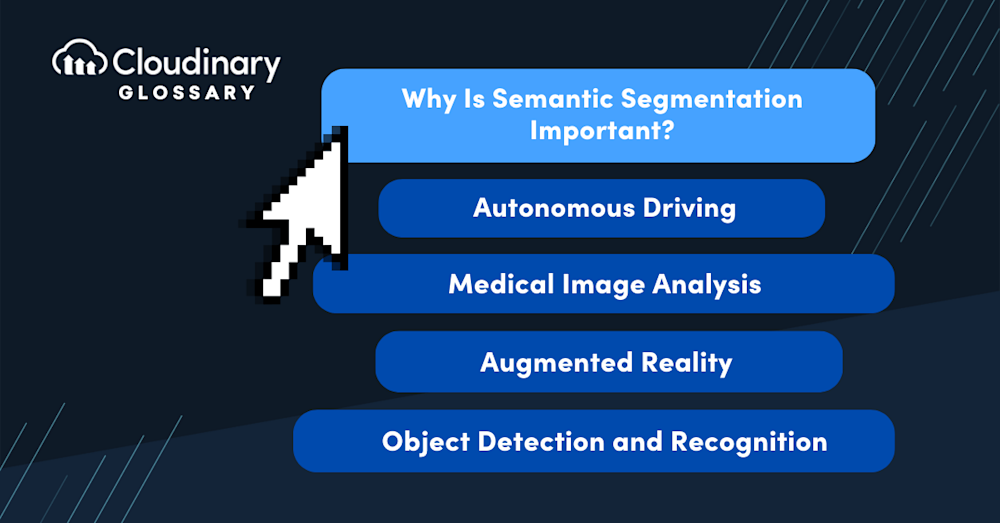What is Semantic Segmentation?
Semantic Segmentation is an advanced image segmentation technique that aims to classify and assign semantic labels to each pixel in an image. Rather than simply dividing an image into distinct regions or objects, Semantic Segmentation allows for a detailed understanding of the content at a pixel level. It assigns labels such as “person,” “car,” “tree,” or “road” to every pixel, enabling precise object recognition and scene understanding.
For instance, consider an image with a variety of objects, such as cars, pedestrians, and traffic signs. Semantic segmentation would categorize pixels corresponding to each object, allowing the machine to comprehend the scene and make intelligent decisions based on its understanding. This differs from other computer vision techniques, like object detection or image classification, in providing a more detailed and complete representation of the image.
How Does Semantic Segmentation Work?
Semantic Segmentation leverages deep learning and convolutional neural networks (CNNs) to perform pixel-wise classification. CNNs are trained on large annotated datasets, where each pixel in the training images is assigned a ground truth label. The network learns to recognize patterns and features related to each semantic class and generates a probability map for each pixel, indicating the likelihood of belonging to a particular class. These maps then assign labels to each pixel, resulting in a segmented image with semantic information.
The process begins with feeding the model an input image, where the first few layers usually extract low-level features such as edges and textures. The deeper layers progressively identify high-level attributes, eventually recognizing whole objects in their distinct classes, such as ‘car’, ‘tree’, and ‘road’. The model outputs a class probability for each pixel, and the pixel is labeled with the class having the highest probability. The result is a segment map where each pixel is labeled, thus providing a detailed, pixel-wise image classification.
Semantic Segmentation vs Other Image Segmentation Techniques
Semantic Segmentation differs from other traditional image segmentation techniques, such as thresholding, clustering, or region growing. Here are some key differences:
- Detailed Pixel-Level Classification – Semantic Segmentation provides detailed pixel-level classification by assigning each pixel a semantic label. This allows for a more comprehensive understanding of the image content than other techniques that only divide the image into regions or objects.
- Fine-Grained Boundaries – Unlike other methods with rough or jagged boundaries, Semantic Segmentation produces more accurate and fine-grained boundaries between different objects or regions. This leads to better object identification and separation.
- Semantic Understanding – Semantic Segmentation enables the extraction of semantic information from images, aiding in higher-level understanding of scenes and objects. It paves the way for applications such as autonomous driving, augmented reality, and object recognition.
- Complex Scenes Handling – Semantic Segmentation can handle complex scenes with multiple objects, occlusions, and overlapping instances. It has the capability to segment and classify multiple objects within an image, even when they are closely located or partially occluded by other objects.
Why Is Semantic Segmentation Important?
Semantic Segmentation plays a pivotal role in several image analysis and computer vision applications:
- Autonomous Driving – In autonomous driving systems, Semantic Segmentation allows vehicles to understand the surrounding environment by identifying and segmenting different objects, such as pedestrians, vehicles, traffic signs, and roadways. This enables safer and more efficient navigation.
- Medical Image Analysis – Semantic Segmentation aids in medical image analysis tasks, such as tumor detection, tissue classification, and organ segmentation. Precise delineation of structures and identification of abnormalities assist in accurate diagnosis and treatment planning.
- Augmented Reality – By segmenting the foreground objects accurately, Semantic Segmentation facilitates realistic and immersive augmented reality experiences. Virtual objects can be properly integrated with the real-world scene by understanding the semantic context of the environment.
- Object Detection and Recognition – Semantic Segmentation serves as a fundamental building block for object detection and recognition systems. It enhances the accuracy and reliability of object localization and identification, enabling applications like visual search and content-based image retrieval.
Conclusion
Semantic Segmentation is an advanced image segmentation technique that allows for detailed pixel-level classification and semantic understanding. With its ability to provide fine-grained boundaries, handle complex scenes, and enable object recognition, Semantic Segmentation has numerous applications in autonomous driving, medical image analysis, augmented reality, and object detection.
To leverage the power of Semantic Segmentation and enhance your image understanding workflows, consider utilizing the capabilities of a comprehensive media management platform like Cloudinary.
Sign up for Cloudinary and unlock the power of your images today.
Additional Resources You May Find Useful:





